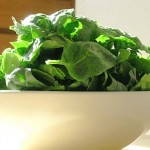Increased radiation in the food near the Fukushima nuclear plant was announced on March 19th. This renews the discussion about food and radiation. There are two similar issues here—one of which can potentially cause harm to humans while the other cannot.
Food that is radioactive can be harmful, although the amounts found so far are relatively small. Food that is irradiated is not harmful to people – as the source of radiation is no longer present or a threat to people.
 In the food near the Fukushima nuclear plant, they found radioactive iodine and cesium in milk and spinach. If one were to eat the food daily from that area – it would result in about 1 mSv over the course of a year. To put it in perspective, the amount of background radiation a person receives from the sun every year is 1-3 mSv. The amount of radiation from a CT scan is about 9.9 mSv.
In the food near the Fukushima nuclear plant, they found radioactive iodine and cesium in milk and spinach. If one were to eat the food daily from that area – it would result in about 1 mSv over the course of a year. To put it in perspective, the amount of background radiation a person receives from the sun every year is 1-3 mSv. The amount of radiation from a CT scan is about 9.9 mSv.
In food sources, it is important to distinguish between irradiated food and food that is radioactive. Irradiated food is food that is subject to radiation- the food itself has no residual radiation in it and does not pose a threat to people. Irradiation is used as a method of pasteurization of food.
Think of it this way – when you pasteurize milk- traditionally it is heated to 161 degrees F (71.7 degrees C) for 15-20 seconds. This kills many (but not all) of the bacteria in the milk and allows milk to have a longer shelf life. However, pasteurization with heat does not mean that milk has residual heat in it.
In foods, radiation is used to destroy or inactivate bugs that can cause spoilage or decomposition – allowing the food to have a longer shelf life. However, the source of radiation is removed and the foods have no residual radioactivity.
In contrast with food near Fukushima plant number one – the particles of radioactive iodine and cesium were absorbed into the food—those substances are still radioactive until they “burn out.” For iodine- every week its radioactivity decreases by half. However, if that food is eaten – then the radiation is inside the person, and they will be subject to it.
The food that is exported to the United States by Japan, will be inspected by the FDA for radiation. It takes 8 days for food to reach the West Coast, so levels of iodine will be half of what they were upon leaving port.
Less than 4 percent of all US food imports come from Japan- while in Canada and Mexico it makes up 29% of their imports. Most food products from Japan are seafood, snack foods, and processed fruits and vegetables.
While the accident at the Fukushima nuclear plant is tragic – it is a local problem in terms of food, and not one that will be an issue in North America.
